 Website:
ZwickRoell GmbH & Co. KG
Website:
ZwickRoell GmbH & Co. KG
Group: ZwickRoell Group
Catalog excerpts
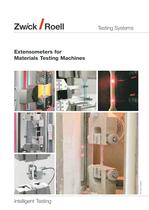
Intelligent Testing Testing Systems Extensometers for Materials Testing Machines FP 282 2.0909
Open the catalog to page 1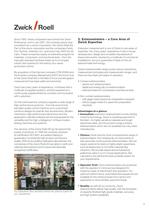
3 2. Extensometers – a Core Area of Zwick Expertise Extension measurement is one of Zwick’s core areas of expertise. Our many years’ experience in the in-house development, design and complete manufacture of these instruments, backed by a multitude of commercial installations, are your guarantee of state-of-the-art extensometer technology. Zwick’s extensometer range covers various resolutions, measurement principles and measurement ranges, and there are two basic principles of operation: • Contact extensometers - sensor arm extensometers - digital and analog clip-on extensometers -...
Open the catalog to page 3
4 Extensometer selection chart 3. Choosing the Right Extensometer for Every Materials Testing Application In materials and component testing the range of applications where extensometers are used is extremely diverse. As a result, the technical requirements for these devices are many and varied, which means that there is no single device which satisfies all needs. The requirements for an extensometer are determined primarily by the characteristics of the material to be tested. This includes its shape and dimensions, test requirements, and the formal standards which must be met. These define...
Open the catalog to page 4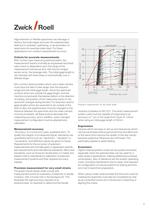
5 150 125 100 75 50 25 0 0 25 50 75 100 125 150 25 ìm 100 ìm High extension or flexible specimens can damage or destroy the knife edges and even the extensometer itself due to whiplash, splintering, or de-lamination of specimens (for example steel rope). For these applications non-contact measurement is a must. Criteria for accurate measurements With contact type measuring extensometers, the measurement travel is normally an engineered and fixed value which is dependent upon the range of the measurement transducer and, with fulcrum hinged sensor arms, the leverage ratio. The initial gage...
Open the catalog to page 5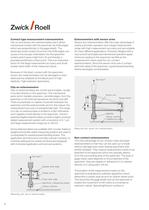
6 Contact type measurement extensometers Clip-on and sensor arm extensometers are in direct mechanical contact with the specimen via knife edges which are perpendicular to the gage length. The extremely small contact force from the knife edges can cause a microscopic indentation into the specimen surface which gives a light form-fit and thereby a precisely positioned contact point. This is an important factor for the large measurement accuracy and small scatter band width of the measured values. Because of the direct contact with the specimen, sensor arm extensometers can be damaged or even...
Open the catalog to page 6
7 background illumination of the specimen optimizes the contrast to the measurement mark. During deformation of the specimen, the lighting changes on the measurement marks as well as on the specimen and surrounding influences (reflections etc.) can influence the optical center point. This is often the cause of scatter in the test results. laserXtens – measurement without gage marks laserXtens, the latest extensometer from Zwick, is a non-contact extensometer which does not require gage marks. It uses the unique structure of a specimen´s surface as a ‘fingerprint’ to generate a virtual gage...
Open the catalog to page 7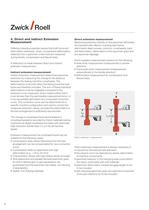
8 Direct extension measurement 4. Direct and indirect Extension Measurement Differing material properties require that both force and deformation (extension, strain, compressive deformation, deflection) for a specimen under load are measured during tensile, compression and flexure tests. A distinction is made between direct and indirect extension measurement. Indirect extension measurement Indirect extension measurement determines specimen extension by measuring the change in the distance between the testing machine crossheads. The deformations of all units within the testing machine load...
Open the catalog to page 8
9 5. Relevant Material Properties 5.1 Extension measurement Extension measurement during loading up to specimen break can be divided into different ranges according to the material properties to be determined: • Fine strain measurements in the elastic range, and at the beginning of the permanent deformation range. • Determination of offset yield from the start of permanent deformation • Determination of uniform strain and strain at break. Fine strain measurement This is primarily used to determine Young’s modulus and the technical elastic limit (0.01% proof strength) for metals and Young’s...
Open the catalog to page 9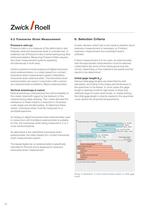
10 5.2 Transverse Strain Measurement Poisson’s ratio (ì) Poisson’s ratio ì is a measure of the deformation ratio between axial and transverse strain in a tensile test. A preferred use of Poisson’s ratio is when testing long-fiber reinforced plastics. Measuring Poisson’s Ratio requires two strain measurement systems operating simultaneously in both axes. Zwick’s solutions include analog and digital transverse strain extensometers, or a video-based non-contact transverse strain measurement system (videoXtens transverse strain extensometer). The transverse strain extensometers are used in...
Open the catalog to page 10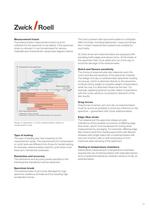
11 Measurement travel The extensometer measurement travel must be sufficient for the specimen to be tested. If the specimen strain is unknown, it can be estimated for various materials and characteristic values (see diagram below). Type of loading The type of loading also has a bearing on the measurement range. The requirements for compression or cyclic tests are different from those for tensile testing, for example, extensometers used for cyclic tests must have zero mechanical hysteresis. Resolution and accuracy The resolutions and accuracy levels specified in the individual test standards...
Open the catalog to page 11
12 7. Overview of Zwick Extension Measurement Systems The selection of a suitable extensometer depends upon the material to be tested, the results to be determined, and the relevant test standard. These criteria and their interdependency are shown in the following tables. Table showing solutions available from Zwick for obtaining test results as per standards Test results Standards Plastics and Elastomers Poisson´s ratio ISO 527 •(2 •(2 - - - - - (•) - - - Tensile modulus ISO 527 • • - • - • - (•) - - • Compression modulus ISO 604 • • - • - • • - - - • Flexure modulus ISO 178 • • - - - - •...
Open the catalog to page 12All ZwickRoell GmbH & Co. KG catalogs and technical brochures
-
Plastics & rubber
56 Pages
-
Extrusion plastometers
12 Pages
-
Image Brochure
20 Pages
Archived catalogs
-
Zwick/ZHU250
3 Pages
-
HC range
2 Pages
-
teachXpert Academia Package
2 Pages
-
Vibrophores 20-30 kN
2 Pages
-
Sheet forming 1000 kN
2 Pages
-
Creep Testing Kappa SS
4 Pages
-
Mflow Extrusion Plastometers
4 Pages
-
HDT/Vicat Allround_cool
2 Pages
-
Cflow Extrusion Plastometers
4 Pages
-
Specimen Grinder
2 Pages
-
Specimen blanking
3 Pages
-
DWT Pellini 550 and 1650
2 Pages
-
HIT pendulum impact testers
24 Pages
-
Hardness Testing with Zwick
24 Pages
-
Sheet forming 100/200 kN
2 Pages
-
TorsionLine 20 up to 500 Nm
2 Pages
-
TorsionLine 1000 bis 2000 Nm
2 Pages
-
roboTest P Metal
2 Pages
-
roboTest F_formstabil
2 Pages
-
roboTest A
2 Pages
-
Vibrophore HFP 5 and 10 kN
2 Pages
-
ProLine
2 Pages
-
PrecisionLine Automatic
2 Pages
-
testXpert II
20 Pages
-
Testing of plastics and rubber
68 Pages
-
HIT Pendulum Impact Testers
24 Pages
-
Hardness Testing with Zwick
36 Pages






























































